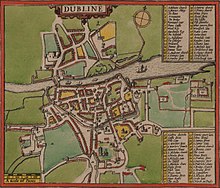Augustinian Friary of the Most Holy Trinity, Dublin
The Augustinian Friary of the Most Holy Trinity was an Augustinian (Order of Saint Augustine (mendicants)[1])[2] Roman Catholic Priory,[3] founded c. 1259,[4][5][6] by the family of Talbot[7] on the south bank of the river, in what is now Crow Street,[8][9] Dublin. At the time the priory was built, it was just outside the city walls.[10] The Friary most likely followed the design of the parent priory Clare Priory in the town of Clare, Suffolk (England).[11] The Friary was suppressed[12] in 1540 when it was described as a "church with belfry, a hall and dormitory".[8][13][14] The friars continued to operate in secret within the city.[10] and there are several mentions of them in the city archives until the late 1700s when they consecrated a new church.
| Monastery information | |
|---|---|
| Order | Order of Saint Augustine |
| Established | c. 1259 |
| Disestablished | 1540 |
| Dedicated to | The Most Holy Trinity |
| Diocese | Dublin |
| People | |
| Founder(s) | The Talbot family |
| Site | |
| Location | Dublin, Ireland |
| Visible remains | Underground, one subterranean wall in St. Cecilia St. |
| Public access | No |
Very little is known of the Augustinian Friary,[15] and the full extent of the friary lands and ancillary buildings have not yet been established,[16] though the area contained by Temple Lane, Temple Bar, Fownes Street Upper and Cecilia Street, is believed to mark the boundaries of the friary. In 1281 Geoffrey FitzLeones and his wife Joanna made a gift of the rents of their lands to the Friary.
The site is shown on John Speed's map of 'Dubline' (1610)(number 11),[17] has been partially excavated, and is listed on the National Monuments Service database,[18][19][20] Those excavations revealed c. 70 burials of late 12th -14th century (1993),[21] surviving remains of the friary on the east side of Cecilia House (1995 (test excavations))[22] and in 1996 excavations exposed a section of wall with a relieving arch and a corner tower.[23][24][25]

Discussion
editNo description of the original friary exists, however, much detail exists on similar and contemporaneous Augustinian friaries in England. Archdall in his 'Monasticon' [26] states "This monastery was very considerable, erected on the banks of the River Liffey, and was the General College for all the Augustinian Friers in Ireland". The buildings alone covered one and a half acres,[27] and would have followed the pattern of an English Augustinian friary, with a number of individual buildings around a courtyard, including a church, cloisters[28] leading to a dining room, dormitory buildings, a kitchen, the Prior's house, with a building set aside for sick and elderly friars, a bakehouse, guesthouse, a house for students, a novitiate house and a house for lay brothers, a garden and also a farm.[citation needed]
References
edit- ^ "Mendicant movement - 01 | St Augustine of Hippo | Order of St Augustine". Archived from the original on 28 April 2014. Retrieved 22 April 2014.
- ^ Order of St. Augustine
- ^ Priory
- ^ Order of Saint Augustine#Ireland
- ^ Martin, F. X. (1956). "The Augustinian friaries in Pre-Reformation Ireland". Augustiniana. 6. Augustinian Historical Institute (Belgium): 347–384.
- ^ Crusensis, N. (1629). Pars tertia Monastici Augustiniani, completens epitomen historicam FF. Augustinensium: magna ordinis unione usque ad an. 1620 cum additamentis Revmi. P.M. Fr. Josephi Lanteri. p. 408.
- ^ Gilbert., J.T., M.R.I.A (1861). A history of the City of Dublin, in Three Volumes (Hardback). Vol. 1. Dublin: James Duffy. p. 170 owned by Author.
{{cite book}}: CS1 maint: multiple names: authors list (link) - ^ a b Brenan, Michael John (1840). An Ecclesiastical History of Ireland: From the introduction of Christianity into that country, to the year 1829. Vol. 1. Dublin: John Coyne. pp. 413–414.
- ^ Casey, Christine (2005). Dublin: The City Within the Grand and Royal Canals and the Circular Road with the Phoenix Park. Yale University Press. p. 440. ISBN 0300109237.
- ^ a b Kelly, David (2005). "The Augustinians in Dublin". Dublin Historical Record. 58 (2). Old Dublin Society: 169–173. JSTOR 30101575.
- ^ conversation with the prior of St. John's Priory Dublin (August 2014)
- ^ Dissolution of the Monasteries#Ireland
- ^ Gilbert, J.T., M.R.I.A. (1861). A history of the City of Dublin, in Three Volumes (Hardback). Vol. 2. Dublin: James Duffy. p. Appendix 1–11, owned by Author.
{{cite book}}: CS1 maint: multiple names: authors list (link) - ^ Gywnn, Aubrey; Hadcock, Richard Neville (1970). Mediaeval Religious Houses:Ireland with a foreword by David Knowles. Longmans. p. 299. ISBN 058211229X.
- ^ Gowan 1996:091 Archived 16 April 2014 at the Wayback Machine
- ^ Gowan 1996:069 Archived 16 April 2014 at the Wayback Machine
- ^ File:Dublin_in_1610_-_reprint_of_1896.jpg
- ^ http://webgis.archaeology.ie/NationalMonuments/FlexViewer [DU18-0020046]
- ^ "Written Answers: Preservation of Archaeological Remains". Oireachtas (Irish Parliament). 22 May 1996. Retrieved 13 November 2013.
- ^ Excavations.ie"1 Cecilia Street/17-19 Temple Lane, Dublin". excavations.ie. Archived from the original on 15 April 2014. Retrieved 13 November 2013.
- ^ Reid 1994, 29
- ^ Gowen 1996, 17-18
- ^ Simpson 1997, 20-21
- ^ FMD map (1978) H3
- ^ Clarke, H.B. (2002). Simms, Anngret; Clarke, H.B.; Gillespie, Raymond; Andrews, J.H; Gearty, Sarah (eds.). Dublin: Part 1, to 1610. Irish Historic Towns Atlas. Vol. 11. ISBN 1874045895.
- ^ Archdall, Mervyn (1786). Monasticon Hibernicum, or, the Monastical History of Ireland. William Mears at the Lamb without Temple-bar. pp. 313–314.
- ^ Butler, Thomas C. (1983). John's Lane:a history of the Augustinian Friars in Dublin 1280 - 1980.
- ^ (from Latin claustrum, "enclosure") is a covered walk, open gallery, or open arcade running along the walls of buildings and forming a quadrangle or garth
External links
edit- Ireland: Dublin, Augnet.org